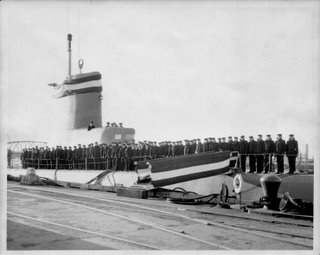USS S-36 (SS-141) Runs Aground
 Originally built in 1918, USS S-36 was, at the time of her construction, on the cutting edge of technology. Armed with four torpedo tubes and a 4-inch gun, S-36 was, along with her sisters of the same "S" class, the workhorses of the American submarine force in the 1920s and 1930s.
Originally built in 1918, USS S-36 was, at the time of her construction, on the cutting edge of technology. Armed with four torpedo tubes and a 4-inch gun, S-36 was, along with her sisters of the same "S" class, the workhorses of the American submarine force in the 1920s and 1930s.A number of "S" class boats were assigned to the Asiatic Fleet, which operated out of American bases in the Western Pacific, including Qingdao, China (then known as Tsingtao) and Manila, Philippines.
When hostilities broke out, S-36 was on patrol in the northern Philippines. Hampered by repeated equipment failures, S-36 ended her patrol on December 18th. After repairs, she was ordered to make a final patrol of Philippine waters, then retire to the East Indies, where Allied forces were gathering after the loss of the Cavite Naval Yard in Manila.
On January 1st, S-36 located a small Japanese transport tied up to the seawall in the port of Calapan, Philippines. She fired a single torpedo at her stationary target and claimed a sinking. However, postwar records could not confirm this.
At the end of her patrol, S-36 was ordered to Surabaya, Indonesia. During the trip, S-36 ran hard aground on a reef in Makassar Strait. Despite damage control efforts, the decision was made to abandon the submarine. Dutch forces evacuated the entire crew, who were reassigned to other submarines and continued to fight.
After all classified material was removed or destroyed, S-36 was left for the sea to claim.
S-36 was awarded one battle star for her WWII service.






